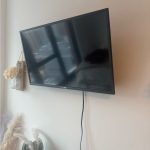Exploring Screen Mirroring Technology
How do I screen mirror to my TV? Screen mirroring is a nifty feature for Android users. It lets you send your phone’s screen to a TV wirelessly. This is great for watching videos, viewing photos, or playing games on a big screen. This tech uses Wi-Fi or Bluetooth to link your phone and TV. Both devices need to be on the same network for it to work. Most TVs and streaming gadgets today support this feature. You will love how your phone turns into a huge display. It’s ideal for enjoying content with family or friends. Next, I will guide you through how to mirror your device using different methods. Stay tuned as we explore the tech behind screencasting.

Step-by-Step Guide to Using Miracast
How do I screen mirror to my TV? Miracast is a wireless technology that makes screen mirroring easy. First, make sure your Android phone and TV both support Miracast. Most new devices do. Here’s a simple guide to connect them:
- Go to your Android phone’s Settings.
- Tap on ‘Display’, then ‘Cast Screen’.
- Your phone will search for TVs nearby.
- Select your TV from the list.
- If prompted, click ‘Start Mirroring’.
Your phone’s screen should now appear on your TV. Movies, games, and apps will show on the bigger screen. Remember, for smooth streaming, both devices need a good Wi-Fi connection.
Troubles with connecting? Check your Wi-Fi network. Sometimes, rebooting your router helps. Make sure both devices have the latest software updates installed. If you still face issues, look for Miracast help in your phone’s support pages or contact customer care.
Miracast is great for videos and games because it has low latency. This means your actions on the phone quickly appear on the TV. It’s like your TV is an extension of your phone’s screen. Using Miracast can transform your TV into a dynamic display for all to enjoy.
Screen Mirroring with Chromecast
Chromecast makes screen mirroring a breeze. Here’s how to do it:
- Plug the Chromecast device into your TV’s HDMI port.
- Connect Chromecast to your Wi-Fi network.
- Download the Google Home app on your Android phone.
- Open the app, tap ‘Cast Screen’, and select your TV.
This method lets you share not just media but full apps on your TV. It works for many types of content. Make sure both your phone and Chromecast are updated. This will ensure the best performance. With Chromecast, casting to your TV is easy and quick.
Remember to check app compatibility. Some apps may not work with Chromecast. For games and videos, use landscape mode for a better view. To stop mirroring, use the Google Home app and disconnect.
Chromecast turns your phone into a powerful entertainment tool for your TV. Perfect for those who want simplicity and speed when casting.
Utilizing Third-Party Apps for Screen Mirroring
How do I screen mirror to my TV? If standard methods don’t work, third-party apps can help mirror your Android screen to TV. Let’s explore this option in detail.
Third-party apps for screen mirroring
For those who need more versatility, third-party apps are the way to go. Apps like AllCast or AirDroid allow for flexible screen mirroring. They support many devices like Roku, Amazon Fire TV, or Apple TV.
To use these apps, first, download and install your chosen app from the Google Play Store on your Android device. Make sure your TV and Android phone are connected to the same Wi-Fi network. Open the app and pick your TV from the list of devices. Hit ‘cast’ to start mirroring your Android screen.
Using third-party apps is handy when built-in options are limited or unavailable. However, choose an app that fits your device best. Always check for app updates to ensure a stable connection. Some may require payment for full features, so consider free trials first.
Benefits of using third-party apps
Third-party apps often provide extra features. They may allow you to stream videos, music, and even mirror web pages. Remember, a strong Wi-Fi connection is vital for uninterrupted streaming. Close other apps on your Android phone to boost mirroring performance. Always read reviews before downloading to ensure app quality.
In summary, third-party apps offer an alternative means to mirror your Android to TV. They expand your options, especially when other methods fall short. Just follow the easy steps, and you’re set for a bigger and better viewing experience. Try different apps and find the one that suits your needs.
In-built Casting on Smart TVs
Modern smart TVs often come with casting features. This makes screen mirroring with your Android device straightforward. If your TV has Miracast, Google Cast, or similar protocols, you’re good to go. First, connect both the TV and Android device to the same Wi-Fi network. Then, look for a ‘Screen Mirroring’ or ‘Cast’ option on your TV menu. Select it, and your TV will search for devices. On your Android, go to ‘Settings’, choose ‘Display’, and tap ‘Cast’. Pick your TV from the list that appears, and you should see your device’s screen on the TV. No extra hardware is needed with these TVs.
A smart choice like the TCL C835 4K Mini LED TV already has casting built in. With it, you can share videos, play games, and browse apps on a big screen. Just a few taps, and your phone’s display is up on the TV. This built-in feature simplifies the whole process. It’s perfect for a quick setup to enjoy content with friends or family. Remember to keep devices updated for the best experience. Enjoy large-scale viewing without cables or additional devices. It’s that easy.

Traditional Mirroring Using HDMI Cable
If wireless methods fail, an HDMI cable can be your savior. Here’s how to connect your Android to your TV using an HDMI cable:
- Get an HDMI cable and a compatible adapter for your Android device.
- Connect the adapter to your phone’s port.
- Plug one end of the HDMI cable into the adapter.
- Insert the other end into your TV’s HDMI port.
- Switch your TV to the correct HDMI input.
- Your phone’s screen should now be on your TV.
This method is straightforward and reliable. It does not depend on Wi-Fi. Thus, it’s great for places with poor wireless connections. It ensures a high-quality display of your Android screen on your TV. This is ideal for high-resolution videos and gaming.
Always check your phone and TV ports to find the right cable and adapter. This ensures a good fit and connection. If unsure, consult your device manuals or look up online specifics for guidance.
Remember, your phone battery can drain fast when connected via HDMI. Keep your charger handy or plug your phone in while mirroring. This way, you won’t run out of power mid-show or during a game.
That’s how you use an HDMI cable to mirror your Android to your TV. This method keeps things simple and does the trick where other options might not be possible.
Tips for a Smooth Mirroring Experience
To make screen mirroring effortless, follow these tips:
Ensure a Strong Wi-Fi Connection
A robust Wi-Fi network is key. It reduces lag and makes streaming smooth. Check your router and move closer if needed.
Keep Devices Updated
Regularly update your phone and TV software. This fixes bugs and improves mirroring.
Adjust Screen Settings
Match your phone’s screen settings to your TV’s. It ensures a clear and correct display.
Choose the Right Adapter for HDMI Connections
Use a proper adapter for your phone when using HDMI. It ensures a good connection and avoids issues.
Close Unneeded Apps
Shut apps you don’t need. This frees up your phone’s resources for a better mirroring experience.
Verify App Compatibility
Make sure the apps you want to mirror work with your chosen method. Some might restrict mirroring.
Invest in Quality Cables
If using an HDMI, get a high-quality cable. This ensures a stable signal between your phone and TV.
Reduce Obstructions
Place your phone and TV with a clear path between them. It helps maintain a strong wireless signal.
Try Various Mirroring Methods
Experiment with different methods. Find what’s most reliable and convenient for you. Each has pros and cons.
By following these tips, you’ll enhance your viewing and gaming when you mirror Android to TV. Enjoy your content on a larger screen without the fuss. Try different ways to see which yields the best results.

Troubleshooting Common Screen Mirroring Issues
How do I screen mirror to my TV? When trying to mirror Android to TV, you might run into some hiccups. Here are common problems and how to fix them.
Connection Problems
Connection issues are frequent. Check if both devices are on the same Wi-Fi network. Restart your router and try again. Confirm that screen mirroring is enabled on your TV settings.
Compatibility Concerns
Ensure your TV supports the mirroring method you’re using, like Miracast or Chromecast. Check your Android phone’s manual or online for compatibility details.
Laggy Performance
If your screen mirroring is slow, your Wi-Fi might be weak. Move closer to the router for a better signal. Close extra apps on your Android to free up bandwidth.
No Sound
If there’s no sound, check your TV’s volume and mute settings. Inspect the audio settings on your Android device to ensure they’re not set to mute.
Quality Issues
Poor video quality can be due to low-resolution settings. Adjust your Android display settings to match your TV’s resolution for clearer images.
App Restrictions
Some apps don’t allow screen mirroring. Check the app’s settings or terms. Try a different app for the content you want to share.
Adapter and Cable Problems
For HDMI connections, ensure your adapter is compatible with your Android phone. A faulty cable can also cause issues. Try a different HDMI cable to see if it works better.
By addressing these common issues, you can improve your screen mirroring experience. If problems persist, consulting manufacturer support might be necessary for further assistance.

